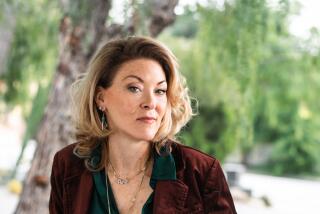Caught on the fly, on the Web
- Share via
Anyone who still maintains that documentary films are the domain of the dry and donnish has never seen the work of Ondi Timoner. Her latest effort, “We Live in Public,” which opened in Los Angeles on Friday, is an aggressively hip telling of the rise, fall and reinvention of new media mogul Josh Harris.
With a dizzying visual style that is a headlong rush of imagery, editing, music and ideas, “We Live in Public” -- which won the Grand Jury Prize after its debut at the Sundance Film Festival, making Timoner the first filmmaker ever to win that award twice -- is culled from 5,000 hours of footage shot over 10 years.
An early Web entrepreneur during the heady dot-com days of the ‘90s, Harris drained his sudden and massive fortune to fund his more outlandish ideas, such as throwing lavish parties as art projects or establishing a bunker in downtown Manhattan where hard-partying residents were subjected to surveillance and interrogations in a uniquely pre-millennial atmosphere that was part bacchanal, part apocalypse. Harris next tried something more intimate but no less invasive, as he and his then girlfriend lived in an apartment rigged throughout with cameras, offering every intimate detail of their lives to Internet audiences.
In a way, Harris was relaying premonitions of our current always-on state of wired living, with the disorienting push-pull between real-world life and online interaction. “I realized everything he’d set up was coming true,” the Los Angeles-based Timoner said recently.
Moving from his days as part of New York City’s Silicon Alley elite to his living on an apple farm, the film ends with Harris in self-imposed exile in Ethiopia. Harris is in L.A., shopping around an Internet television project that builds on his ideas of interactive surveillance.
“I know how to make the new magic,” Harris said of his apparent knack for eyeing the next big thing. “This film is like a trailer to help me get around town.”
The relationship between Timoner and Harris is complicated. It started out as employer-employee with Timoner working for Harris at his early online broadcast channel called Pseudo.com and later being hired to document the bunker project.
Over time their relationship became driven by certain symbiotic needs -- Timoner wanting to finish her film, Harris wanting the film to help launch his return. “You may argue whether you’re being gamed or not,” said Timoner, allowing for the complexity of the personal/business/artistic connections that now bind them. “I would argue I’m not gaming you with my movie. I’m really trying to take an authentic look at Josh’s life without judgment.”
Though he was at Sundance and has been traveling with the film to festivals ever since, Harris had long refused to watch “We Live in Public.” He finally did so just last week, recording his reactions for a DVD commentary track.
After all that buildup, what must it have been like for him to finally watch Timoner’s portrait, in particular the sequence that relentlessly documents a period of his life when relationships crumbled, a fortune collapsed and he seemed to be heading toward a total personal breakdown?
“She did the light version,” said Harris. “It was weird seeing it. It wasn’t just like, ‘I’m crazy, I’m losing my mind.’ . . . The hardest part of the whole thing for me was seeing how fat I was. Oddly enough, that was the disturbing part.”
--
Wallace ode owed
When the news came last September that author David Foster Wallace had taken his own life, John Krasinski had just finished “Brief Interviews With Hideous Men.” Opening in Los Angeles on Friday, the film is Krasinski’s debut as writer and director and the first screen adaptation of a work by Wallace.
“Finding out we had lost him, the only pressure there had nothing to do with the movie and everything to do with him,” recalled Krasinski by phone. “My fear of his fans and everything went right out the window, and I only hoped I was doing him proud, that he would have approved of this and enjoyed it. That will remain my biggest fear about it.”
Wallace’s story is a series of first-person narrations, as various men describe the darker corners of their psyches. Krasinski created a female character (played by Julianne Nicholson) to conduct the interviews and also cast himself against type as a cad-ish ex-boyfriend, at odds with his on-screen persona from “The Office.”
“The movie is [Wallace’s] writing, plain and simple,” Krasinski said of the adaptation process. “I can’t take credit for much, and I can also admit that the movie will only be a fraction of the experience you have in reading one of his books. That’s just a plain fact.”
--
More to Read
Only good movies
Get the Indie Focus newsletter, Mark Olsen's weekly guide to the world of cinema.
You may occasionally receive promotional content from the Los Angeles Times.










